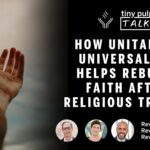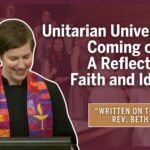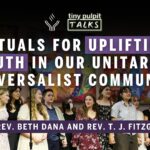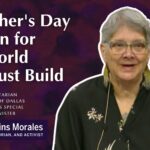Sacred Geography: Sanctuary | Rev. Dr. Daniel Kanter | 02.25.24

Let’s explore how to be witnesses to how we hold things dear.
This is the second sermon in the Sacred Geography sermon series, where we are locating sacred touchpoints in our inner world and the world around us.

Sermon Transcript
Would you harbor me? Would I harbor you? This isn’t a vague question. This is a real spiritual question as we wade into the tides and waves of our theme year and Lent. Would you harbor me? Would I harbor you?
You see, harboring someone is offering someone protection or shelter. It’s offering them refuge. It’s offering them sanctuary. What I’m asking you is if you have the spiritual inclination and the strength and the courage to shelter someone in need. The answer may be immediately yes, yes, maybe runaway woman or child, poet, prophet, or king. That might be easy, right? What about heretic? Depends on who’s chasing him? Refugee? Tubman? Spy? Now, we wade into political waters. How is our courage?
Well, let’s stick with the spiritual question would you harbor a Palestinian or Israeli soldier, a scared or injured Trump supporter, someone whose values conflicted with yours? Would you harbor a teenager wanting an abortion, a trans teen being attacked by the whole Republican Party, a woman freed from prison, a wanted immigrant, a runaway gang member? How about a Yankee fan? Let’s not push it. Let’s not push it, those of us who come from the Northeast.
The Sacred Act of Offering Sanctuary
Offering sanctuary means offering something sacred. We don’t need those words on the screen right now. Sanctuary, like this beautiful place, we don’t need the computer on the screen. But the beautiful place that this is can hold that, too. Sanctuary comes from Latin means sanctus, means holy. Historically, sanctuary by the law of the medieval church meant a fugitive or someone who was running from the authorities could go to the church sanctuary, and if they had one hand on the pulpit, they were immune from arrest for 40 days of immunity. Forty days, that comes again.
Over history, this rite of sanctuary became weaker and finally was abolished all together. But the concept of a church or other religious sanctuary as a safe place for one needing refuge from the authorities or from the powers that be or from the world itself never went away, because the idea is that there is a higher law than human law you might call God’s law. And the Church had a role in sanctuary throughout American history, that is for sure, in abolition, in the Vietnam War, protecting those avoiding the draft. Anyone here took sanctuary in church in the Vietnam War?
In the ’80s, the Church was a place for Central Americans running from genocide. And some churches offer sanctuary today to immigrants who are undocumented or refugees who don’t have asylum. I agreed with the church board some years ago when some other UU churches were housing immigrants that we could be in the process of supporting them if approached by someone who was being deported, that we would be sanctuary, not housing them here in the church or one hand on the pulpit, but we would be a network of church members’ homes to keep them safe and hidden. To date, that hasn’t happened, but there’s still time.
The Risks and Responsibilities of Sanctuary
Knowing sanctuary involves risk also is part of it. Trying to keep people safe means sometimes making ourselves less safe. It requires sometimes people with certain types of privilege to assume the risks of the less privileged, to become more vulnerable. That’s what it is to be sanctuary, the sacred act of embodying the reality that we are all one, that we are all in this, that we are all sharing the risk of holding what is holy up in the world that wants to divide us with what is unholy. Would you harbor me?
Naomi Shihab Nye has a beautiful poem about this, not from the Church, but from the world. She remembers the great singer Paul Robeson, who the State Department perceived as a threat, calling him a communist, a threat to national security. So that he was forbidden to travel, his passport was revoked in May of 1952 on his way to a concert in Vancouver, Canada. He was detained at a checkpoint in Washington state. And Nye’s poem called Cross the Line tells this story.
She says this, “Paul Robeson stood on the northern border of the USA and sang into Canada, where the vast audience sat on folding chairs waiting to hear him. He sang into Canada. His voice left the USA when his body was not allowed to cross that line. Remind us again, brave friend, what countries may we sing into? What line should we all be crossing? What songs travel toward us from far away to deepen our days?”
Paul Robeson stood on that northern border of the US and sang into Canada. There were 5,000 people gathered on the American side and 30,000 on the Canadian side.
Our Church as a Community of Sanctuary
My friend Victoria says this of the Church, “We are here to hold and to harbor each other. All of us, present and not present, as each of us struggles to hear and answer our true calling, we are clumsy and imperfect, we are brave and we’re not always brave. Come remind me again what countries I may and must sing into, what lines I should be crossing with my body, with my heart. These are not discernments I can make in solitude. I have come to be reminded of and blessed by certain sacred covenants like this in the Church.”
And I say to you today, this is me speaking to you, that those covenants, those promises to hold space for each other always, to be sanctuary, to harbor when possible, at least to make room in your heart for others’ fears and struggles, that is part of this faith. And if we don’t practice that with regularity, we are just tourists here. We are just consumers of this faith, living vicariously through the ones we see who do. If we can’t open our hearts like we have opened this sanctuary, even to see the humanity behind the news and the people who are afraid and the people we’re afraid of and the people we disagree with, we are failing our liberal faith and its history.
Even the architecture of this church is asking us to be sanctuary, not only just here in this place, but out in the world. Once this was named as a clearing in the forest. Doesn’t it look like a clearing in the forest? It used to have trees here when they built it first. But it was a clearing and a sanctuary to protect liberals in 1962 who were afraid of a violent and abusive city of Dallas. You know the history.
But a few years ago, when we built all this extra space on the campus, we put a passage through the campus, an architectural feature that goes from this street all the way out to that other street so that we can see the world and we can ask ourselves, “Are we leaving this sanctuary, this protected, nourishing place and going out into the world and giving it to others?”
If there’s one thing in my ministry, besides the parking under the Y, it’s that passage that you can remember when I’m long gone, because I have been asking you about this for years. Can we take what we are nourished by here out into the world?
I want to tell you a story that’s at the center of this idea about this church. My colleague and church member, Lyssa Jenkens, told us a story a few years ago. And I went back and found out more from her about it. She told me that once this sanctuary, this sanctuary, this place of safety and harbor and holding, these very walls that we sing each first Sunday of the year that song that says, “May they keep hate out and love in,” these walls in the 1980s held a special group of people, not you who were here in 1980s, not Unitarians worshiping. You’re special, but you’re not the group I’m talking about.
She told me she was living with a woman who was a devout Catholic. So they were settled here in Dallas and they joined Dignity, a gay Catholic church. It was in the mid 1980s, and Dignity was no longer allowed to meet at Holy Trinity on Oak Lawn down the street because of AIDS. They met at a member’s home until someone discovered they were welcome to meet in Raible Chapel, that room you walk through on the Normandy side to come here each Sunday. And when a priest of that group was understanding how many young Catholic men were dying of AIDS without any access to the sacrament of confession and reconciliation, he found other colleagues. And somehow, he gathered other priests who then agreed to offer the services to the AIDS community with him at First Unitarian Church in this sanctuary.
So an evening every week, priests met with these men. One priest sat in each corner of this sanctuary, and as men began to arrive, Lissa said to me, “I was just an observer in the back. I have no idea how long we were there. I believe it moved from light to dark in the process. And dozens of men showed up, some still strong and others so sick they could not walk without assistance. And they waited in the pews, these pews that you are in right now, until it was their turn to sit with a Catholic priest. And the litany of words and the cries of relief and the spiritual and the physical touch of the blessing created an atmosphere that sanctuary, pain and sickness, relief and joy was palpable here in this place. And they just kept coming and receiving embodied holy, holy love and respect in a time when they had been treated like lepers in their beloved Catholic churches.”
And Lyssa said to me something I will never forget. She said, “You could see the little bit of dignity, maybe some peace they took with them, many quite tearfully as they left the room still facing inevitable suffering and death.” Would you harbor me?
When I heard Lyssa tell me this, I remembered all the ways that this church has harbored and been harbored. Our existence, in fact, starts with the harboring of Temple Emanuel in 1899 when no Trinitarian church in Dallas would host a bunch of heretic Unitarians. And we paid that forward to the Muslims of North Texas, mostly engineers from TI who met in our library in the 1970s and became IANT and Richardson, the Richardson Mosque, one of the largest in the country. And we paid that forward to the Cathedral of Hope, who started in the 1980s, maybe at the same time in Raible Chapel.
And we’ve harbored groups like the Student Nonviolent Coordinating Committee who organized in church in the ’60s their protests against civil rights laws that kept them down. And we integrated in 1945, saying to Black members of Dallas community that we wanted them to worship with that white congregation of the time. And just this week, we harbored abortion travel patients that we took to New Mexico that we’ve been taking for two years now since SB8. And we created Friends for Good, an organization that helps make relationships between us and Jews and Muslims and evangelicals. It was hardest for us and the evangelicals. Let’s face it.
Harbor, sanctuary, not only fitting for our theme year, tides, purpose, waves change. The harbor protects from violent waves that divide and conquer us. And we will not stop being that.
The Call to Individual Action
And it is not just us. It is not just this that is sanctuary. It is you who can be sanctuary, you who can do what Pamela Bailey, the Black historian, activist, singer asked us to do right here from this stage last week when she was leading us in a song of reclaiming a version of Dixie in which we were singing, “Don’t look away.” And if you missed it, you missed it, but it was great. “Don’t look away,” was the final word of that event. Don’t look away from history. Don’t look away from people who are different from you. Don’t look away from what is happening in the world because it’s more comfortable.
All that needs you. It needs you to be sanctuary by giving it more of your attention. You can be sanctuary by just giving the people in your lives a little more eye contact, my wife reminds me of this all the time, a little more eye contact than the iPhone camera gets. You can be sanctuary in little ways that harbor and hold those in need and those in struggle.
William Sloane Coffin, the great preacher of Riverside Church in New York City asked a beautiful question in one of his last sermons. He asked, “Who tells you who you are?,” which is another way of asking, “What covenants are you bound by? Who harbors you and whom do you harbor?” He said, “Some people rely on money to tell them who they are. Some rely on status and power. Some need enemies to tell them who they are.” “Too many of us, too often,” he said, “allow our own mistakes to tell us who we are. We look through the murky lens of shame or regret at our own shabby jumble of stumbles and sins and defined ourselves by these alone.” “No other measure will convince us,” he said. “This is grandiosity and such delusion,” he said.
“Who tells you who you are?,” Coffin responded by quoting Isaiah. He said, “‘I have called you by name. You are mine,’ sayeth the Lord.” And then he said this, “For one thing, you never have to prove yourself. God’s love is poured out universally on everyone from the Pope to the loneliest wino on the planet. God’s love doesn’t seek value. It creates it. Our inherent value is a gift, not an achievement. So you never have to prove yourself with money or power or perfection. You only need to express yourself and,” this is the key, “abundantly return the love you’ve been given so abundantly.” Abundantly return the love.
He was preaching this because he wanted everyone there in his church to know they belonged, not by virtue or by anything that they had done, anything they had earned, but by virtue of who they are, which is beloved, which is so easy to forget, which is easy to lose sight of when the world is so tumultuous.
And it’s easy to forget that our jobs are to return that love, to harbor and give sanctuary to those in our lives around us and in the world, and not just to focus on ourselves, but also to ask the question, “Whose are we?”
I want to close with the story about a desert monk. Lots of stories about desert fathers. They were early Christian hermits who lived in Egypt and Palestine and other places in the third century. This one story is about a monk who lived many, many years, and every night he went out and lit a lantern by the roadside to cheer the weary travelers who might be passing by. Beside the lantern, there was a note which gave detailed directions to his cottage if the traveler was in distress or in need. It was not important to him who the stranger would’ve been or why they would come. The important thing was that the lantern burned every night, and every night there was a note there just in case.
I have seen similar roadside markers in Buddhist countries, sometimes with water and fruit, not as offerings to the Buddha, but for travelers. The offerings speak volumes that no matter who the passerby is, no matter what language he or she speaks, no matter what faith they practice or what mission they are on, the offering is a little harbor, is a note saying, “Just in case.” And that makes all the difference.
Would you harbor me? Would I harbor you? Would you let yourself be harbored? Would you harbor a Palestinian or Israeli soldier, a scared or injured Trump supporter, someone whose values conflicted with yours? Would you harbor a teenager wanting an abortion, a trans teen being attacked by the whole Republican Party, a woman freed from prison, a wanted immigrant, a runaway gang member, a person living with AIDS? Would you let yourself be harbored?
Please do. Please live your faith with courage. The world needs you. Amen and amen.







